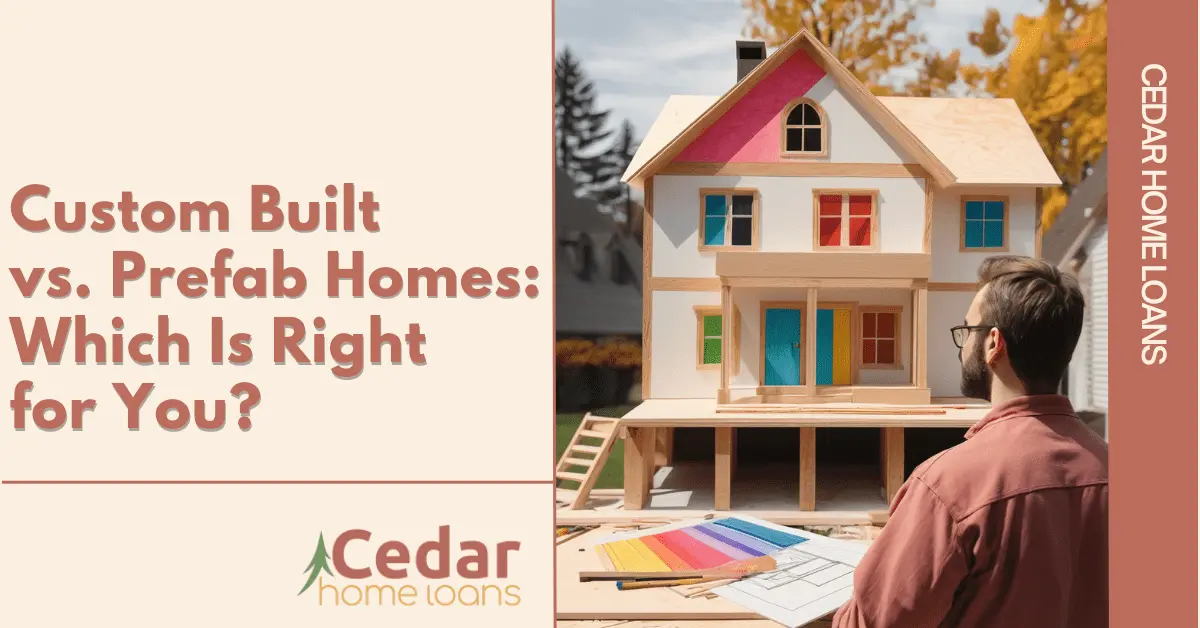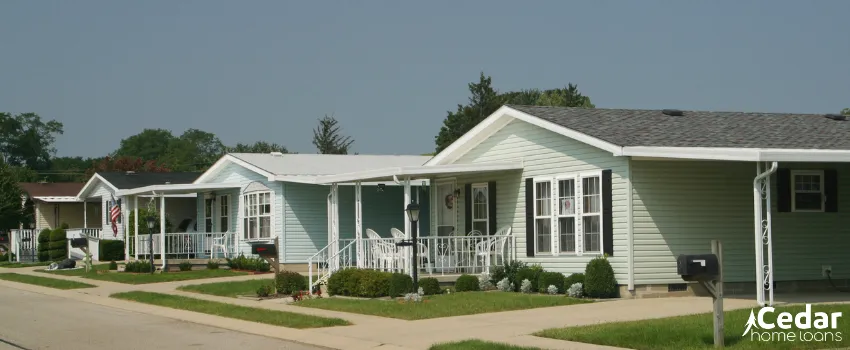Deciding to build your dream home is an exciting and fulfilling journey. It allows you to create a space that reflects your personality, meets your unique needs, and comforts you and your family. However, before you can start turning your vision into reality, you must make one crucial decision: Will you go for custom-built or prefab homes?
Custom-built and prefab homes offer different advantages and considerations, and understanding their pros and cons is essential in making the right choice. To help you with this decision, we’ll discuss what are prefab homes and delve into the details of each option to explore their construction processes, costs, and other significant factors to consider.
What Are Prefab Homes?
Exactly what are prefab homes? Prefab homes, or pre-fabricated or modular homes, are built off-site in a factory or manufacturing facility. They are constructed in sections or modules and then transported to the homeowner’s desired location for assembly.
These homes can range from single-family houses to multi-unit dwellings and can be customized to some extent. There are different types of prefab homes, including:
- Panelized Homes
- Manufactured Homes
- Mobile Homes
While all these options fall under the prefab category, they differ in construction and adherence to building codes. Modular and panelized homes are typically built to meet local building codes and offer more customization choices, resembling traditional homes.
On the other hand, manufactured and mobile homes are constructed to comply with national building codes set by the Department of Housing and Urban Development (HUD) and are often more limited in customization.
Characteristics of Prefab Homes
What are prefab homes known for? Spotting prefab homes can be tricky because they look identical to traditional, site-built houses once assembled. Here’s a list detailing what prefab homes are known for:
1. Distinctive Seams Or Lines
Prefab homes are often made up of multiple sections or modules, so if you notice any visible seams or lines where the different parts of the house are joined together, it’s a strong indication that it’s a prefab.
2. Building Materials
Exactly what are prefab homes made of? Some prefab homes have exterior walls that are made of metal, vinyl, or cement boards. Conversely, houses with brick, stone, or wood exteriors are typically site-built.
3. Label Or Marker
Look for a manufacturer’s label or marker near the main electrical panel or inside a kitchen cabinet. This is a surefire way to know if the house is a prefab home.
4. Foundation
Check the foundation type. If it’s a concrete slab or blocks with crawl space, it can be both site-built and pre-fabricated homes. However, if it has a basement, it’s less likely to be a prefab home.
The Pros and Cons of Prefab Homes
Benefits
If you’re considering a prefab home, weighing its pros and cons is essential to make an informed decision. Let’s start with the benefits.
1. Faster Construction
Since the components of prefab homes are constructed in a factory, the overall building process can be completed in a shorter time frame than custom-built homes.
2. Cost-Effective
Prefab homes are generally more affordable because of the ability to purchase materials in bulk and the reduced labor costs associated with the streamlined construction process.
3. Quality Control
The factory construction of prefab homes allows for greater control over the quality of the materials and workmanship, as it takes place in a controlled environment.
4. Energy-Efficient
Many prefab home manufacturers prioritize energy efficiency and incorporate modern green building techniques, resulting in potential cost savings for the homeowner in the long run.
Drawbacks
The disadvantages of prefab homes include:
1. Limited Customization
Compared to a custom-built home, the level of customization in prefab homes is often more restricted, as the design choices are pre-determined or have limitations due to the pre-built components.
2. Land Restrictions
Some prefab homes, such as manufactured homes, may be subject to specific zoning or community restrictions, limiting where they can be placed.
3. Financing Challenges
Certain lenders may have stricter financing requirements for prefab homes, particularly for manufactured homes, which can make securing a loan more challenging.
What Are Custom-Built Homes?
Custom-built homes are precisely what they sound like—homes that are tailor-made to meet the specific preferences and requirements of the homeowner. Unlike prefab homes, constructed off-site, custom-built houses are typically built on the homeowner’s chosen land.
Building a custom home involves collaboration between the homeowner and an architect or a custom home builder. The process starts with creating a unique home design, considering the homeowner’s vision, desired layout, and any special features.
Once the design is finalized and the necessary permits are obtained, the construction of the custom home begins. This process can take several months to complete, depending on the size and complexity of the design.
The Custom-Built Home Construction Process
Local builders or contractors the homeowner hires typically take care of the construction of custom-built homes. The construction process involves several phases, including:
1. Design and Planning
The homeowner works with an architect or a home designer to create a unique floor plan and exterior design that meets their requirements.
2. Permitting
The builder obtains the necessary permits and approvals from the local government before construction can begin.
3. Site Preparation
This step includes clearing the land, leveling the site, and making necessary utility connections.
4. Foundation and Framing
The builder pours the foundation and constructs the home’s framework, including the walls, roof, and floors.
5. Interior and Exterior Work
Once the basic structure is in place, the construction team carries out the interior and exterior work, such as electrical and plumbing installation, HVAC systems, insulation, and the application of siding or brickwork.
6. Finishing touches
The final phase of construction focuses on the aesthetic elements of the home, including painting, flooring, cabinetry, and other custom features requested by the homeowner.
The construction timeline for a custom-built home can vary depending on the size, complexity, and availability of labor and materials. On average, it takes 10 to 16 months to complete a custom home, but it can take longer for more intricate designs or in areas with challenging weather.
It’s worth noting that while prefab homes generally have a shorter construction timeline, their life span can be shorter than that of a custom-built home, depending on the materials and construction quality.
Pros and Cons of Custom-Built Homes
Benefits
Custom-built homes offer a wide range of benefits, but they also come with some considerations. Let’s dive into the pros of custom-built homes:
1. Design Flexibility
One of the significant advantages of custom-built homes is the ability to create a personalized living space that reflects the homeowner’s unique style, preferences, and functional needs.
2. Choice of Location
Unlike prefab homes, which are limited to specific areas, custom-built homes can be constructed on the homeowner’s preferred site, whether in a particular neighborhood, rural area, or any desired location.
3. Quality Craftsmanship
Many custom home builders often have a reputation for delivering high-quality work. They use premium materials and employ skilled craftsmen to bring the homeowner’s vision to life.
4. Future Expansion
In most cases, custom-built homes are designed with future expansion in mind. This means adding additional rooms or features down the line can be easier, saving the homeowner from the potential hassle and expense of moving.
Drawbacks
On the other hand, the disadvantages of a custom-built home include:
1. Longer Construction Time
Building a custom home typically takes longer than purchasing pre-fabricated homes. The construction process is often more complex, involving various stages and coordination among different contractors.
2. Higher Cost
Custom-built houses are generally more expensive than prefab homes, primarily due to the added costs of customization and higher-end materials.
3. Construction Risks
Since custom-built houses are constructed on-site, there is a potential for construction delays and unforeseen challenges, such as inclement weather, which can impact the timeline and overall cost.
Which One Should You Choose?
Ultimately, the choice between a custom-built and a prefab home depends on your specific needs, budget, and preferences. To help you make a well-informed decision, consider the following:
Choose a prefab home if:
- You have a limited budget – If you’re looking for a more affordable housing option, pre-fabricated homes can be a great choice, given their cost-effective nature.
- You want a quicker move-in – Prefab homes are ideal if you have a time-sensitive need or desire to move into your new home quickly since they are typically constructed faster than custom-built homes.
- You are satisfied with standard designs – What are prefab homes primarily known for? That’s right, pre-determined designs. If you’re comfortable with standard designs and have no specific customization requirements, pre-fabricated homes can provide you with just that.
Choose a custom-built home if:
- You value design uniqueness – If having a home that reflects your individuality and distinct taste is a top priority, a custom-built home is perfect for you. Custom-built houses offer the freedom to create a unique design that matches your style and functional needs.
- You have specific requirements or preferences – A custom-built home allows you to incorporate specific features, layouts, and materials that might not be feasible with pre-fabricated homes. This is ideal for your individualistic needs, such as accessibility features, eco-friendly materials, or unique room layouts.
- You’re willing to invest more time and resources – While typically more expensive and time-consuming than pre-fabricated homes, custom-built houses give you the flexibility to be involved in every step of the process, from designing to choosing the materials, ensuring that every aspect of your home is exactly as you envisioned.
Key Takeaway
When deciding between pre-fabricated homes and custom-built houses, consider that prefab homes offer affordability, quicker construction, and some customization, suitable for those with budget constraints and time-sensitive needs.
On the other hand, custom-built homes provide extensive design flexibility and quality craftsmanship. They are ideal for those seeking a unique home tailored to specific preferences and willing to invest more time and resources. Your choice should align with your personal needs, budget, and desired customization level.
Start Your Dream Home Journey With Cedar Home Loans
Make your dream home a reality with Cedar Home Loans! Whether you’re leaning towards a prefab home or a custom-built masterpiece, we can provide you with flexible Keystone home loans to support your vision financially. Contact us today to explore tailored loan solutions that will help you achieve your dream home!





